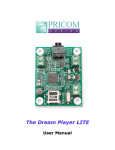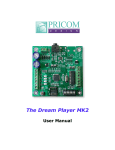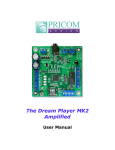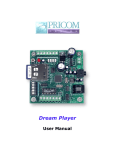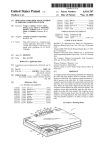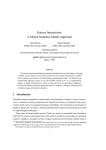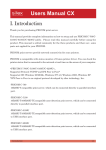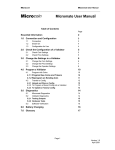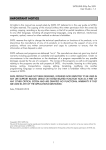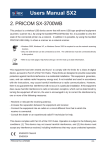Download PRICOM Design Dream Player Users Manual
Transcript
The Dream Player PRO User Manual Dream Player PRO User Manual Version 1.1 Copyright ©2013 PRICOM Design Table Of Contents 1 2 Overview .................................................................................... 2 Using the Dream Player PRO ................................................... 3 2.1 2.2 2.3 2.4 2.5 2.6 2.7 2.8 2.9 2.10 2.11 2.12 3 Connections ............................................................................... 7 3.1 3.2 3.3 3.4 3.5 3.6 4 Page 1 Updating Your Firmware ................................................................................... 21 Downloading the Firmware Update ................................................................... 21 How to Update Your Firmware .......................................................................... 21 Problems & Support ................................................................ 22 6.1 6.2 6.3 7 General Mode Setup ........................................................................................... 16 Trigger Input Configuration ............................................................................... 17 Control Output Setup ......................................................................................... 18 Track Playback Setup ......................................................................................... 19 Audio Mode Configuration ................................................................................ 20 Firmware Updates ................................................................... 21 5.1 5.2 5.3 6 Power Input .......................................................................................................... 7 Audio Output Connector ...................................................................................... 8 Trigger Input Terminal Strip ................................................................................ 9 Control Output Terminal Strip ........................................................................... 11 Mode Switches ................................................................................................... 14 Mounting Holes .................................................................................................. 14 Introducing the CONFIG.TXT File ......................................... 15 4.1 4.2 4.3 4.4 4.5 5 3.3V and 5.0 Volt Power Indicator LED‟s ........................................................... 3 Status Indicator LED‟s ......................................................................................... 4 PLAY Button........................................................................................................ 4 PNET Control....................................................................................................... 4 Trigger Input ........................................................................................................ 4 Audio Output ........................................................................................................ 4 Power Input .......................................................................................................... 4 Control Output...................................................................................................... 5 SD Card and Socket ............................................................................................. 5 Mode Switches ................................................................................................. 5 Creating WAV Files ......................................................................................... 5 Loading the SD Card ........................................................................................ 6 Help, I broke it! .................................................................................................. 22 E-mail ................................................................................................................. 22 Web Site ............................................................................................................. 22 Dream Player Specifications ................................................... 23 Dream Player PRO – User Manual Using your Dream Player PRO 1 Overview Congratulations! You have just received an extraordinary little device. The Dream Player is the perfect tool for audio playback of multiple files without any moving parts. Packed full with an extensive array of features, while measuring only 3 ½ by 4 ½ inches (90mm X 115mm), this is truly the best item of its kind. Your sound files are stored on a micro SD Card readily available at any electronics store as well as through PRICOM Design. We have tested sizes ranging from 512MB-16GB from a variety of manufactures and have success with them all. This means you could have 25 hours of CD quality music playing in your project using a 16GB SD Card. Also by using a micro SD Card you are able to mount the board to anything and anywhere, and easily change out or update the sounds that the device plays. What about quality? The PRO supports exceptionally high quality 44.1 KHz, stereo, 16bit, WAV Files. If you received a PRO-HD your Player is also capable of playing WAV files samples up to 24bit & 96 KHz. Using a High Fidelity, 24bit, Stereo DAC the Dream Player is capable of playing some remarkably good quality sound. You may also control the PRO via external controls such as a button or motion sensor, as well as control Output devices such as LED‟s with it. The PRO also may be integrated with external PRICOM Input / Output Boards and communicate view the PRICOM Network (PNET) to giving you the ability to have multiple trigger locations as well as up to 32 separate audio files. Another exiting feature of the Dream Player PRO is the “CONFIG.TXT” file that is stored on the SD Card. With this file you may change the characteristics of the Player. Things such as how long a fade out can be? Should it be 5 seconds? 1 second? None at all? Would you like the sound file to play only while you hold a button? How about starting the track when the button is released and stop playing when pressed again? These are just a handful of configuration combinations that you may have, and the beauty of it all is that you may change it at anytime and to your exact situation. Included with the Dream Player packaging is a CD containing sample Audio Files, a sample CONFIG.TXT File, the complete User‟s Manual, and several other items to make your experience as enjoyable as possible. So read within to learn about the many exciting features of The Dream Player PRO. PRICOM Design Page 2 Using your Dream Player PRO 2 Using the Dream Player PRO The following pages describe the Configuration and operation of the Dream Player. You can keep it as simple, or make it as complicated as you wish. With so many options and Configurations available to you, the possible uses are endless. 2.1 3.3V and 5.0 Volt Power Indicator LED’s The Dream Player Pro takes the power input and regulates it to both 3.3 and 5.0 volts. Two separate LED‟s indicate whether sufficient power is present to operate each supply. If both are lit then the PRO has ample power, should one or both LED‟s not illuminate then there may not be sufficient power being supplied to the Dream Player. Page 3 Dream Player PRO – User Manual Using your Dream Player PRO 2.2 Status Indicator LED’s SD Card Status: This is a Green LED and it will light when the SD Card is properly inserted and the Dream Player is able to read the files on the card. PNET Activity: When the Dream Player receives data over the PRICOM Network (PNET) this Yellow LED will light, indicating that the PRO is receiving data over the PNET. Playback Indicator: Whenever the Dream Player is playing a file or reading data from the SD Card the Red Playback indicator will light up. 2.3 PLAY Button To play the first Track on the SD card at any time, you can simply hit the PLAY button. If you press the PLAY button when the Dream Player is already playing, the sound will fade out and stop, or whatever the settings on the CONFIG.TXT file may be set for. This button is also used to update firmware when a new version becomes available. 2.4 PNET Control The Dream Player PRO may be controlled via external PRICOM trigger boards using the PNET enabling you to individually control up to 32 separate files. The Dream Player communicates to these trigger boards using the 6 wire modular jacks. 2.5 Trigger Input This input is the way to control the activities of the Dream Player. In its factory state, when the Dream Player is idle, the trigger input will cause the track to play. While the Dream Player is playing a track, any kind of trigger input will cause the current track to fade out. Now any of the above mentioned scenarios may be customized using the CONFIG.TXT file as described latter in this manual. 2.6 Audio Output Audio is supplied by the Dream Player by means of a standard 1/8 inch (3.5mm) stereo jack. You may use any standard powered computer speakers as described in the next section. You can also directly drive non-powered speakers, i.e. headphones, but the volume may be fairly low. It is advisable that an Amplifier such as the PRICOM Dream AMP be used if you are using the Dream Player with non-powered speakers. 2.7 Power Input The PRO may be supplied with AC or DC power ranging from 9-18 Volts and will draw about 220ma when playing. The polarity actually is irrelevant on this board, you may hook up the wires in either way and the device will still power on. PRICOM Design Page 4 Using your Dream Player PRO 2.8 Control Output As its name implies, you may use these connections on the Dream Player to control up to four outputs such as LED‟s, Relays, etc… The outputs will activate relative to their track number/trigger number, but there is plenty more to learn about this feature in section 3.4. 2.9 SD Card and Socket Your Audio content, CONFIG.TXT File, and any firmware updates are loaded onto a micro SD FLASH Card, and then inserted into the SD Card Socket. The connector used on the Dream Players is unique in that the card is loaded from the top and not from the front like standard connectors. One major feature of this style is that it ensures that the card does not accidently fall out when the device is mounted. To load the card into the connector, simply insert the card into the socket from the top and while pushing down with your finger, pull towards yourself, you will feel when it is secure. If the card is not properly fitted into the socket, it will actually pop back up, the only time the card will remain down is when it is correctly inserted into the connector. 2.10 Mode Switches The Dream Player has an on board DIP switch that is used to designate the “slot number” for use with external PNET Trigger Boards. Switches 1-4 will set the number that the PNET will associate with that particular board. For more information about this feature please see the user‟s manual for the PNET Input/output boards. . 2.11 Creating WAV Files Any suitable sound editor can be used to create WAV files. The Dream Player PRO will play Stereo, 16-bit samples, at a 44.1KHz sample rate. This is the same format used for CD Players and is quite standard. The PRO-HD may support up to 24bit, 96 KHz. Note: The Dream Player can NOT play MP3 files or other non-wav files. Please visit the PRICOM Design web site (www.pricom.com), for some ideas and tips on creating your own WAV Files. We recommend numbering your files once you load them onto the SD Card. The Dream Player will understand the numbers „1-‟, „2-‟, „3-‟, etc… when placed in front of the file name. These numbers indicate to the Dream Player what „track‟ they are. If you do not number the files, the Dream Player will not recognize the files, so it is very important to include the “-” at the beginning of the file name. You can name your files anything you want. For your convenience, you can name the files something sensible like “Mountain Day.wav” on your computer, and then rename the file once it is on the SD Card. A good file name is something like “1-Mountain Day.wav” which would be treated as Track-1. Page 5 Dream Player PRO – User Manual Using your Dream Player PRO During normal operation the Dream Player will play track 1 by default when the on-board button is pressed or is triggered from an outside source via the trigger input. 2.12 Loading the SD Card In order for the Dream Player to read the files, they must be copied onto the micro SD Card. Any standard SD Card reader attached to any computer can be used. The Dream Player will accept any brand of SD Card, in any capacity up to 16GB. Simply copy your wav files onto the micro SD Card. The Dream Player will not look in any folders or sub-directories for its files. After you copy the files onto the SD Card, a file may be renamed at any time. The PRO will accept fragmented cards, meaning you do not have to delete all files off the card before loading your news ones on. For example if you had 4 tracks on your card and you wanted to change track 2 you can simply delete the old track and put the new one on the card, without having to delete and then rewrite ALL the files. PRICOM Design Page 6 Using your Dream Player PRO 3 Connections The following section provides detailed instructions for connecting your Dream Player PRO. To get started quickly, all you need to do is connect the Power Input, and the Audio Output. Then when you are ready, you can get more advanced and use the Trigger Inputs and Control Outputs. 3.1 Power Input The Dream Player can accept AC or DC power inputs. Typically a wall transformer, or wall-wart is used, but any suitable AC or DC power supply can be used. Any voltage from 9V to 18V AC or DC can be used, but the higher the voltage, the warmer the Dream Player will run. The most efficient voltage to use is 12VDC, especially when using in combination with PNET trigger boards, 12VDC is highly recommended. At this voltage, the Dream Player will draw about 220mA when playing, so use a power supply that can supply at least 250mA of current. If you wish to power multiple Dream Players, a single larger power supply can be used, just allow for 250MA for each Dream Player you wish to power. As a convenience to you, we also offer walltransformer power supplies tested and ready to run with your Dream Player at www.pricom.com The power source used can be shared with other devices, but be careful as the Audio Ground will be referenced to this power source. If you observe a buzzing or other interference noise, it would be best to give your Dream Player its own power supply. To connect the power supply to the Dream Player, locate the 2-position “Power Input” terminal strip. If your desired power-supply comes with a connector on the end, simply clip it off as shown to the right. Separate the two wires and strip some insulation off to expose the actual wires then twist them to keep the strands together. Secure the stripped wire ends to the 2 terminals of the Power Input terminal strip. The polarity of an AC or DC power source is not important as there is a bridge rectifier included with the Dream Player. Page 7 Dream Player PRO – User Manual Using your Dream Player PRO 3.2 Audio Output Connector The Dream Player can drive any audio amplifier, powered speakers, or media speakers that are typically used on a computer. Prices of media speakers are quite reasonable and you may obtain then from practically every computer store and electronic outlet. Depending on the quality and volume you are trying to achieve, these speakers can be purchased anywhere from $15-$50, or as high as $100+. We have found that many of the $35-$50 speakers sound terrific for any application and meet most of our customer‟s needs just fine, and some of them are quite small and easy to conceal. Choose your speakers wisely as the best audio you can get is often times limited by the quality of the speakers you choose. If you are at a loss for what speakers to get, we offer some reviews of speakers we have purchased on-line with some links to how you may purchase them. Please visit www.pricom.com To connect the speakers to the Dream Player, you simply plug-in the stereo plug from the speakers into the Audio Output jack on the Dream Player. You can insert as many extensions as needed to accomplish your wiring. These extensions are 1/8” stereo cables, and sometimes are sold as headphone extension cables. Again many electronic stores will sell this item. To avoid „blowing something up‟ set the volume on the speakers‟ pretty low to start with, and then adjust as appropriate for your sounds and speaker setup. All sounds are clearly not created and mixed on equal levels, and we would hate for you for blow a good set of speakers after start-up. To state the obvious, start low and work your way up from there. PRICOM Design Page 8 Using your Dream Player PRO 3.3 Trigger Input Terminal Strip More than simply playing a sound file, your Dream Player is capable of acting and reacting based on input from you or the devices it is controlling. This section describes the electrical connections for the Trigger Inputs. The Trigger Inputs of the Dream Player are optically isolated which means you can wire the inputs so that they are electrically isolated from the Dream Player. Why is that important? Because sharing a common ground between an Audio Playback system and any other system can, and usually does, create ground loops and noises such as „buzz‟ and „hum‟. By isolating the Trigger Inputs, we have removed this problem for you! As a convenience to your wiring, you may use the power supplied on the Trigger Input Terminal Strip, but doing so will defeat the isolation offered by the Dream Player. If you are simply wiring switches or buttons, there isn‟t much chance of a „ground loop‟ or „noise‟, so we give you the best of both worlds. Figure 1 – Trigger Input Terminal Strip Pinout (P4) Terminal 1 2 3 4 5 6 7 Name GND Trigger-1 Trigger-2 Trigger-3 Trigger-4 POS 5V Description Convenience power supply ground Opto-Isolated Trigger #1 Input Opto-Isolated Trigger #2 Input Opto-Isolated Trigger #3 Input Opto-Isolated Trigger #4 Input Opto-Isolator Shared Power Input Convenience power supply (5VDC) The trigger input terminals (Trigger-1 to Trigger-4) provide connection to the low-side (Cathode) of the LED in each opto-isolator. Current limiting resistors are built-in, so you can simply connect any Trigger Input to GND to cause the Trigger to occur. Terminal #6 (POS) is connected to the high-side (Anode) of all 4 opto-isolators. Typically Terminal #6 is connected to the power source to be used to trigger the inputs. This can be an external power source or Terminal #7 (5V), if you do not need to isolate the Dream Player ground. The internal current limit resistors are suitable for voltages from 5VDC up to 24VDC. If higher voltages are required please contact us to determine suitable added current limit resistors. Terminal #1 and Terminal #7 provide a local power source that is not isolated from the Dream Player, but can be used to simplify wiring if just using push-buttons, relays, or other input that doesn‟t require optical isolation. The following example shows how to connect switches (or relays for that matter) directly to the Dream Player without utilizing the ground isolation features of the opto-isolators. Page 9 Dream Player PRO – User Manual Using your Dream Player PRO The convenience 5VDC power supply from the Dream Player is jumped to the optoisolator POS terminal to supply the shared LED Anodes. Each Trigger Input can then be individually connected to the convenience GND pin though any suitable switching device such as a push-button or relay. Figure 2 - Simple Trigger Input Button Connections Note: The actual function of each Trigger Input is determined by the settings in the CONFIG File. More detailed application information is located in Section-4 of this manual. In the next example, we will use an external power supply to enable the opto-isolators to completely isolate the Dream Player Ground from the controlling device. Notice that the POS terminal is used, but not the 5V or G terminals. Opto-isolator power is supplied from the external 4-24VDC Power Supply. Figure 3 - Isolated Trigger Input Button Connections PRICOM Design Page 10 Using your Dream Player PRO The switch examples shown above don‟t really need the opto-isolators, so where would you need the opto-isolators? How about connecting to a DCC Decoder! In the next example, we will connect a Digitrax TF4 to allow the Dream Player to be controlled directly from your DCC System. Any brand of mobile or stationary decoder could be used, but the low-cost of the TF4 lends itself nicely to this application. Here we have connected the 4 function outputs of the TF4 to the 4 Dream Player Trigger Inputs. Since the DCC Decoder must be connected to the DCC System, where there is considerable noise, some kind of isolation would really help us here. The Dream Player opto-isolators keep the DCC system completely isolated from the Audio Ground and remove any chance of noise entering the sound system and speakers. Note that the 5V and the G terminals are left un-connected since the opto-isolators are being powered from the DCC decoder lamp power lead. Figure 4 - Isolated DCC Decoder Connections . Note: The actual function of each Trigger Input is determined by using the CONFIG.TXT File. 3.4 Control Output Terminal Strip The Dream Player is capable of controlling many types of devices and loads connected to the Control Outputs. This section describes the electrical connections for the Control Outputs. The Control Outputs of the Dream Player are not isolated in any way from the Audio Ground of the Dream Player. Why is that important? Because sharing a common ground between an Audio Playback system and any other system can, and usually does, create ground loops and noises such as „buzz‟ and „hum‟. If grounding problems become an Page 11 Dream Player PRO – User Manual Using your Dream Player PRO issue for your application, an external relay can be used to isolate the load from the Dream Player. As a convenience to your wiring, you may use the power supplied on the Control Output Terminal Strip, but doing so will draw power from the internal 5V regulated supply used to power the Dream Player. Use this convenience power for LED‟s, small relays, or triggering another Dream Player, but if you intend to power any larger loads, please consider an external power source for the Control Outputs. Figure 5 – Control Output Terminal Strip Pinout (P6) Terminal 1 2 3 4 5 6 7 Name GND Output-1 Output-2 Output-3 Output-4 Clamp 5V Description Convenience power supply ground Control Output #1 Control Output #2 Control Output #3 Control Output #4 Common Clamp Diode Connection Convenience power supply (5VDC) The control output terminals (Output-1 to Output-4) provide connection to a Darlington Transistor Array (Collector) used to Sink Power, but cannot Supply Power. Each Output is capable of sinking 400MA using the ULN2803 in the socket at U7. The Darlington Array has its Emitters connected to the GND Terminal #1. External or Convenience power can be used to power the load, but the reference and current ground will be using GND Terminal #1. Terminal #6 (Clamp) is connected to the Darlington Array protection diodes (Cathode) for all 4 outputs. If you are driving an inductive load such as a relay, the Clamp terminal should be connected to the power source being used for the load. This Clamp Terminal will prevent the back-lash of the relay from destroying the Darlington Array. If simply driving LED‟s this terminal can be left un-connected. Terminal #7 provides a local power source that is not isolated from the Dream Player, but can be used to simplify wiring if just powering LED‟s or other small loads. Power used from this terminal can cause the on-board voltage regulator to become hot under load. The following example shows a simple way to connect status LED‟s to the Dream Player using the convenience 5VDC power supply. The LED‟s will require current-limiting resistors since each Control Output can sink 400MA and would burn-out the LED‟s. Since the LED‟s do not present an inductive load, the Clamp terminal has been left unconnected. PRICOM Design Page 12 Using your Dream Player PRO Figure 6 - Simple Control Output LED Connections Note: The function of each Control Output is determined by the CONFIG.TXT File. See the information contained in this manual about functionality The Dream Player can also be used to drive conventional DC powered lamps or DC powered relays. Using external relays allow much higher power to be controlled, or even AC Line voltage. The possibilities are endless, but the next example shows how to connect external lamps or relays using an external power source. The external power source is used for this example so that not too much power is consumed from the Dream Player‟s on-board 5VDC power supply regulator. If the relays are high-efficiency and can be powered from 5VDC, then the on-board 5VDC power source could be used. In the following example, we are using an external power source. Page 13 Dream Player PRO – User Manual Using your Dream Player PRO Figure 7 - Lamp/Relay Control Output Connections The common lamp/relay connection must be to the Positive terminal of the power supply, and also is connected to the Clamp terminal to utilize the Dream Player‟s built-in protection diodes. The external power supply Negative terminal is connected to the GND Control Output terminal. This arrangement causes the positive voltage to flow though the lamp/relay, into the Control Output terminal, and back out the G Control terminal, and complete the circuit at the power supply negative terminal. Because the Dream Player uses a Darlington Transistor array for the output control switching element, AC power cannot be used, only DC is possible. 3.5 Mode Switches The Dream Player has an on board DIP switch that is used to designate the “slot number” for use with external PNET Trigger Boards. For more information about this feature please see the user‟s manual for the PNET Input/output boards. 3.6 PNET Control The Dream Player PRO may be controlled via external PRICOM trigger boards using the PNET enabling you to individually control up to 32 separate files. The Dream Player communicates to these trigger boards using the 6 wire modular jacks. 3.7 Mounting Holes The Dream Player can be mounted to any non-conducting surface using the supplied mounting holes. Although there are not any components on the back of the PRO, using some form of stand-off would be advisable to keep from breaking anything and more importantly avoid any unwanted short circuits. The mounting holes are electrically isolated however, and using steel screws is fine, but please do be careful not to over tighten them. PRICOM Design Page 14 Using your Dream Player PRO 4 Introducing the CONFIG.TXT File Upon first glance the CONFIG.TXT file looks intimidating, but is pretty self explanatory, and easy to use. The below screen shots are exactly as they appear directly off a PRICOM Design supplied micro SD Card, downloaded off our website, or from the included CD. We will just go ahead and simply go down the list of what we can do with this awesome little file. First off; To make a Function ACTIVE, remove the “#” from in front of it. If a feature is not applicable to your situation and you do not need it, simply insert a “#” in front of the name. Think of the “#” as commenting out a line of the code. You may name the file whatever you want just so long as it starts with “CONFIG” and ends with .txt. For example “CONFIG-bobsstuff.txt”, “CONFIG.txt” and “CONFIGthisismysampletestfile.txt” would all work. There should only ever be one CONFIG.TXT file on the micro SD Card. The CONFIG.TXT File does not have any file size limit, you may write as much you want, and make as many comments as you wish. Overall the nice thing is that if for some reason you forget what a particular function does, the description is found in the file and will pretty much just explain itself. The CONFIG file used by the PRO is a little different from the versions used on the Dream Player LITE and MK2. First off there are many more features and settings that you may configure. Secondly there are two lines to each feature of the CONFIG file. The first being a description illustrating an example of how to set the feature, the second line is where you can set whether you want that feature active and select which files you want to associate with that function. Page 15 Dream Player PRO – User Manual Using your Dream Player PRO 4.1 General Mode Setup Feature Background Mode Auto Start Loop Mode Multi Random Track Resume Description In addition to the normal pre file numbering 1-,2-,3-,4-. You may have a track “0-” that acts as a “background” track. When you use this feature, the Dream Player will continuously play the 0- track forever and loop when it reaches the end. Background mode implies Auto Start and Loop mode for Track 0. Activating this feature will Auto Start the designated file. If you select file number 5 then that track will Auto Start upon power-on of the Dream Player. You can select up to 6 different files to Auto Start, just simply enter the track numbers after the AutoStart=. For every one of the files you can also set loop mode, which means at the end of file playback the file will loop back to the beginning. For example if you list tracks 1,2,5 as the Loop files, those files will loop to beginning of the file once it reaches the end rather than stopping. For instance if you had five files on your card and triggered them all at the same time then 1,2, and 5 will play through to the end and loop back to the beginning, and tracks 3 and 4 will play to the end and stop. This feature allows random playback of a particular track number from up to 8 sub tracks. For example you can have up to 8 files named track 1 and with Multi Random the Dream Player will select randomly from those files labeled “1-” With the PRO you can set multi random on a track by track basis. This enables you to specify which tracks you would like to have operated under Multi Random Mode. If you had 4 tracks for example you can select tracks 1 & 2 to operate using Multi Random, and tracks 3 and 4 will operate normally. This feature will enable the Dream Player to remember where it stopped playing so when you retrigger the track it will continue playing where it left off rather than going all the back to the beginning of the track. This is quite handy for really long track tracks. PRICOM Design Page 16 Using your Dream Player PRO 4.2 Trigger Input Configuration Feature Loop While Trigger High Trigger NO Retrigger Toggle Trigger Page 17 Description Just as its name implies this feature will make the Dream Player continue to loop the file and play it over and over, so long as the trigger/input is active. If you are using a button as your input, then if you press and hold the button the file will play continuously. Release the button and the file will play to the end and then stop. Instead of playing the file when the trigger input is closed, this reverses the trigger logic so that it plays when open. With a button as an example of input then the file will play when the button is released “open” and then stop playback when you press the button “closed”. This is a great option for motion detectors that have a “normally closed” signal. This feature can be very important for a motion sensor. If you set the trigger or a trigger comes during playback the Dream Player will ignore any inputs during playback. If you think of a Motion Sensor, objects can be passing in front of the sensor constantly triggering it which in normal playback would be no use being the track would constantly fading in and out, stopping playback and instantly starting again. With No Re-Trigger once the track is triggered it will play until the end of the track ignoring all other trigger events, at which point the Player will look and see if there are other triggers. Think of having a literal toggle switch, which when in the open position plays the first track and in the closed position plays the second track. Something new on the PRO is that toggle trigger can be applied to any track. To set which track will play for the different positions, you will name your track 1a- for a switch in the OFF/Open position, and 1b- for a track in the ON/closed toggle position. Dream Player PRO – User Manual Using your Dream Player PRO 4.3 Control Output Configuration Feature Control Start Control End Control Play Control Loop Control Pulse Time Description The Control Output will become active when a track starts, and will remain active for the length of time described in the Control Pulse Time setting later in this section. Please note that this is only when the track starts and will not pulse when the track loops. Just the opposite of the Control Begin, the output device will become active for the specified amount of time after the file plays. The control output will simply stay active as long as the file is playing. In the case of a looping track this setting will activate the control output at the loop point, i.e. the end of the track. You may define exactly how long the output is active. Times may be set either across all tracks or on an individual basis. Times are defined in Milliseconds, with1000MS amounting to 1 full second, you can actually set your output to pulse for just 1MS. If both Control Begin and End features are disabled then the pulse time is not used. PRICOM Design Page 18 Using your Dream Player PRO 4.4 Track Playback Configuration Feature No Fade Fade Out Time Fade In Time Page 19 Description One of the more self explanatory features in the file. If you want the Dream Player to fade, leave this feature disabled with a “#” in front of it. If you want the audio to instantly stop instead of fading then activate the feature. A neat feature of this CONFIG.TXT file is that you may customize the fade time exactly to the millisecond that you need. You may use anything from 1MS to 65000MS. If you have No Fade enabled then the fade time is irrelevant. Contrastingly you also may need a Fade In time for track resume to work properly. It works exactly the same as the Fade Out Time only these settings set how long the Fade In time should be. Setting a nice fade out time and then fade in time when resuming is a good idea so that when the track resumes it does not suddenly jump into something really loud, a fade in time would make the transition a lot smoother. Dream Player PRO – User Manual Using your Dream Player PRO 4.5 Audio Mode Configuration Feature Master Volume Track Volume ALL Track Volume – 1,2,3,4 Description The output volume of the Dream Player may be adjusted to your situation. For example if you have a set of speakers in your project but cannot access the volume on the physical speaker you may adjust the volume that the Dream Player produces. Sort of a secondary Master Volume, this sets the output volume of all tracks to the specified amount. If you have a track that was recorded at a lot higher audio level then the other tracks or vice versa, You may want to set the volume for each individual track, This effectively provides you with a handy little mixer inside the Dream Player without having to hook up any additional hardware. You may ask why do you not just set everything to 100? The reason being is that if each file is recorded at normal digital full scale like a CD is recorded, the output of all four files combined will be too much for the output and you will actual hear it start to compress. It will not clip or crunch, but the quality will be affected, we did do an internal software limiter to prevent any audio abnormalities; however we do advise that you set the volumes to something less than 100 to receive the best possible audio quality. If you are only using one or two tracks then having the volume set at 100 will not be a problem. PRICOM Design Page 20 Using your Dream Player PRO 5 Firmware Updates 5.1 Updating Your Firmware Another very special feature of the Dream Player is the convenience of easily updating firmware, no cables needed. Revisions of firmware are loaded onto the micro SD Card which allows you to load any critical updates to the firmware without having to totally dismantle your project to get the unit to your computer. 5.2 Downloading the Firmware Update When firmware updates become available we will announce it on our website www.pricom.com. On the download‟s page find the updated version of firmware and click the download link. The firmware updates are a special PRICOM Design file called PDI, which means your machine will most likely not recognize the format and so you will be prompted with a box asking if you want to Find, Save, or Cancel. You will want to SAVE the file, and to a folder somewhere that makes sense and you can find it, creating a folder called “PRICOM Downloads” would be a good example. After you save the file to your machine you may simply copy it to your micro SD Card. It is best to have only one firmware file on the SD Card. 5.3 How to Update Your Firmware To initiate the firmware update process just follow the steps below. 1. 2. 3. 4. 5. 6. 7. 8. Power off the Dream Player. Remove the micro SD Card. Load the Card into your computer. Copy the PDI File onto the card. (Ensure there is only one .PDI file on the card.) Insert the card back into its position on the Dream Player. (important) Hold down the onboard button while reapplying power. Reapply power to the Dream Player. The SD Card Status and Playback Indicator LED‟s will flash four times to indicate the unit is in update mode. 9. You may stop holding down the button at this point. 10. The Red LED will rapidly strobe while the update is taking place. Next the Yellow LED will flash while the firmware is verified. 11. Generally the update takes only a few seconds and upon completion of the update the LED will stop flashing, and you are ready to go. Note: Remember to hold down the button when reapplying power to the unit. Otherwise the Dream Player will not look for the Firmware. Page 21 Dream Player PRO – User Manual Section 6 – Problems & Support 6 Problems & Support Our goal is a product that is robust and trouble-free for you, however in the real-world, problems unfortunately do arise. 6.1 Help, I broke it! If you are not happy, then we are not happy! If you have a mishap with your Dream Player, please let us know. Contact us at the e-mail below if you have questions or problems. Generally the problems end up being simple fixes that can be diagnosed and repaired by you the user with help from us here. 6.2 E-mail If you are experiencing trouble with your Dream Player, please let us know. We are here to help you, and want your experience to be creative and fun. If you need help of any kind, please contact us via e-mail. The support e-mail address is [email protected]. 6.3 Web Site The PRICOM web site is where we will post any upgrades, updates, and improvements. Please be sure to check for Hardware and Software updates. www.pricom.com PRICOM Design Page 22 7 Dream Player Specifications 9-18V AC or DC Connection using 2 position terminal strip Current consumption approximately 220mA while playing Power Input: 3 ½ inches X 4 ½ Inches (90mm X 115mm) Trigger Input: 4 Inputs for Switches or Contact Closures Connection using 7 position terminal strip Optically isolated with built-in current limit resistors Control Output: 4 Outputs may be used for relays, lamps, LEDs, and other trigger able devices. Connection using 7 position terminal strip Pulls to GND. Output rated for 400mA Audio Output: Line Level Stereo Analog Audio Output Connection using 3.5mm (1/8”) Stereo Jack Allows direct connection of amplified ‘media speakers’ May also use non-powered speakers, such as headphones Audio Formats: 16bit, stereo (PRO) Up to 24bit stereo (PRO-HD) Sample Rates: 44.1KHz (PRO) Up to 96 KHz (PRO-HD) Output Level: 3V Peak-To-Peak Maximum Storage Device: micro SD FLASH Card 64MB up to 16GB Files use about 10MB/minute. 64MB holds about 7 minutes 1GB about 100 minuets 2GB about 3 hours 16GB about 25 hours Storage Format: FAT, FAT32 formatted cards (standard) File Format: Standard WAV files placed in the root folder of the card Page 23 Power Input: Dream Player PRO – User Manual Dream Player PRO User Manual Version 1.1 Copyright ©2013 PRICOM Design


























